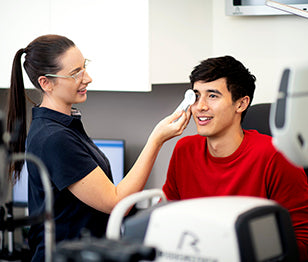What you need to know about keratoconus

Keratoconus (pronounced: ker-uh-toe-koh-nus) – otherwise known as conical cornea – is a degenerative eye disease. It happens when the cornea (the clear front surface of the eye) thins. As it progresses, the cornea develops a cone-like bulge which can result in some significant visual issues.
It often affects both eyes to varying degrees and symptoms usually develop when people are younger (aged 10-25).
What should I look for?
If you’re noticing any of these symptoms, get in to see your optometrist as soon as you can.
- Blurred, distorted or double vision
- Sensitivity to light or glare
- Frequent changes to your prescription
- A sudden change or clouding of your vision
- Halos or flaring around light which can make driving at night difficult
What causes keratoconus?
There’s no hard and fast cause, but it looks like genetics could be a risk factor - with 20% of people with the condition also having a relative who has it. People with asthma, allergies or hayfever are believed to be more at risk because excessive eye rubbing can damage the fibres of the cornea.
Those living with diseases like Down's Syndrome, Marfan's Syndrome, Ehlers-Danlos Syndrome may also be genetically predisposed.
How is it treated?
While there is no cure for keratoconus, treatment can help to slow or stop the progression of the disease and correct vision loss. If caught early, this can be done with glasses or contacts.
As it progresses your optometrist might recommend rigid contact lenses or therapies like corneal cross-linking. If it gets to the advanced stage, you may need a corneal transplant.
But the good news is early detection and treatment of the condition can help you stabilise symptoms and prevent the condition worsening.

We're here to help
If you have any questions about keratoconus or concerns about your vision speak to your optometrist or book an appointment today.
You might also like to read...
View all-
Understanding astigmatism
There’s a good chance you’ve heard of astigmatism before. It’s a common eye condition that causes blurred vision, discomfort in your eyes and headaches.
Eye conditionsUnderstanding astigmatism
There’s a good chance you’ve heard of astigmatism before. It’s a common eye condition that causes blurred vision, discomfort in your eyes and headaches.
Read more -
Learning more about cataracts
You’ve probably heard of cataracts – when the normally clear lens of the eye becomes cloudy. It happens because the lens becomes hardened, and it means a gradual decrease in...
Eye conditionsLearning more about cataracts
You’ve probably heard of cataracts – when the normally clear lens of the eye becomes cloudy. It happens because the lens becomes hardened, and it means a gradual decrease in...
Read more -
The ins and outs of colour deficiency
You might know colour deficiency by its other name – colour blindness. This name isn’t technically correct, as most people living with colour deficiency can actually still see colours.
Eye conditionsThe ins and outs of colour deficiency
You might know colour deficiency by its other name – colour blindness. This name isn’t technically correct, as most people living with colour deficiency can actually still see colours.
Read more





